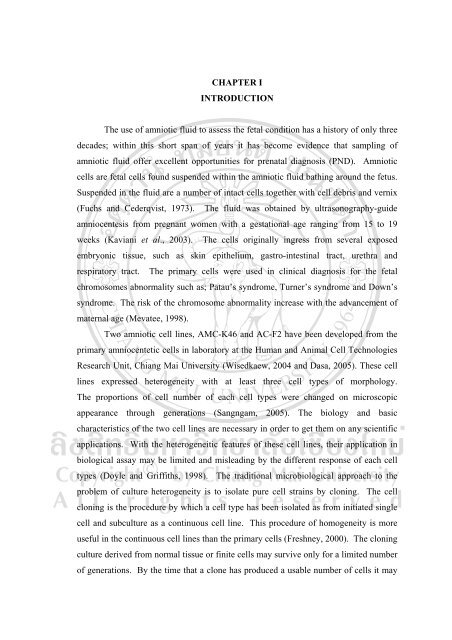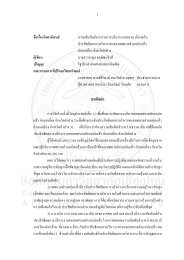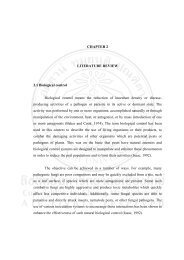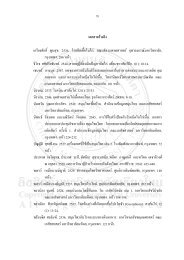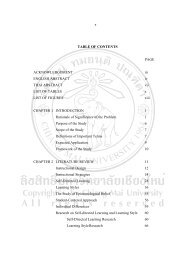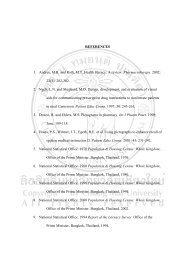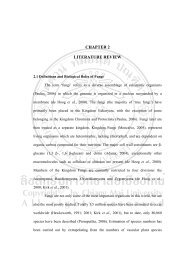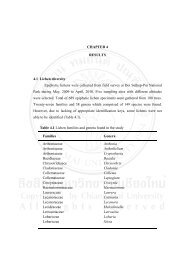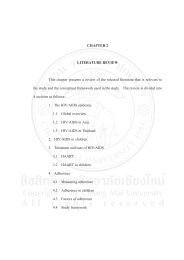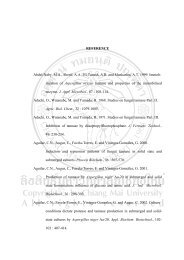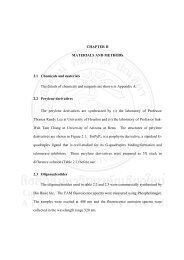CHAPTER I INTRODUCTION The use of amniotic fluid to assess the ...
CHAPTER I INTRODUCTION The use of amniotic fluid to assess the ...
CHAPTER I INTRODUCTION The use of amniotic fluid to assess the ...
You also want an ePaper? Increase the reach of your titles
YUMPU automatically turns print PDFs into web optimized ePapers that Google loves.
<strong>CHAPTER</strong> I<br />
<strong>INTRODUCTION</strong><br />
<strong>The</strong> <strong>use</strong> <strong>of</strong> <strong>amniotic</strong> <strong>fluid</strong> <strong>to</strong> <strong>assess</strong> <strong>the</strong> fetal condition has a his<strong>to</strong>ry <strong>of</strong> only three<br />
decades; within this short span <strong>of</strong> years it has become evidence that sampling <strong>of</strong><br />
<strong>amniotic</strong> <strong>fluid</strong> <strong>of</strong>fer excellent opportunities for prenatal diagnosis (PND). Amniotic<br />
cells are fetal cells found suspended within <strong>the</strong> <strong>amniotic</strong> <strong>fluid</strong> bathing around <strong>the</strong> fetus.<br />
Suspended in <strong>the</strong> <strong>fluid</strong> are a number <strong>of</strong> intact cells <strong>to</strong>ge<strong>the</strong>r with cell debris and vernix<br />
(Fuchs and Cederqvist, 1973). <strong>The</strong> <strong>fluid</strong> was obtained by ultrasonography-guide<br />
amniocentesis from pregnant women with a gestational age ranging from 15 <strong>to</strong> 19<br />
weeks (Kaviani et al., 2003). <strong>The</strong> cells originally ingress from several exposed<br />
embryonic tissue, such as skin epi<strong>the</strong>lium, gastro-intestinal tract, urethra and<br />
respira<strong>to</strong>ry tract. <strong>The</strong> primary cells were <strong>use</strong>d in clinical diagnosis for <strong>the</strong> fetal<br />
chromosomes abnormality such as; Patau’s syndrome, Turner’s syndrome and Down’s<br />
syndrome. <strong>The</strong> risk <strong>of</strong> <strong>the</strong> chromosome abnormality increase with <strong>the</strong> advancement <strong>of</strong><br />
maternal age (Mevatee, 1998).<br />
Two <strong>amniotic</strong> cell lines, AMC-K46 and AC-F2 have been developed from <strong>the</strong><br />
primary amniocentetic cells in labora<strong>to</strong>ry at <strong>the</strong> Human and Animal Cell Technologies<br />
Research Unit, Chiang Mai University (Wisedkaew, 2004 and Dasa, 2005). <strong>The</strong>se cell<br />
lines expressed heterogeneity with at least three cell types <strong>of</strong> morphology.<br />
<strong>The</strong> proportions <strong>of</strong> cell number <strong>of</strong> each cell types were changed on microscopic<br />
appearance through generations (Sangngam, 2005). <strong>The</strong> biology and basic<br />
characteristics <strong>of</strong> <strong>the</strong> two cell lines are necessary in order <strong>to</strong> get <strong>the</strong>m on any scientific<br />
applications. With <strong>the</strong> heterogeneitic features <strong>of</strong> <strong>the</strong>se cell lines, <strong>the</strong>ir application in<br />
biological assay may be limited and misleading by <strong>the</strong> different response <strong>of</strong> each cell<br />
types (Doyle and Griffiths, 1998). <strong>The</strong> traditional microbiological approach <strong>to</strong> <strong>the</strong><br />
problem <strong>of</strong> culture heterogeneity is <strong>to</strong> isolate pure cell strains by cloning. <strong>The</strong> cell<br />
cloning is <strong>the</strong> procedure by which a cell type has been isolated as from initiated single<br />
cell and subculture as a continuous cell line. This procedure <strong>of</strong> homogeneity is more<br />
<strong>use</strong>ful in <strong>the</strong> continuous cell lines than <strong>the</strong> primary cells (Freshney, 2000). <strong>The</strong> cloning<br />
culture derived from normal tissue or finite cells may survive only for a limited number<br />
<strong>of</strong> generations. By <strong>the</strong> time that a clone has produced a usable number <strong>of</strong> cells it may
2<br />
already be near <strong>to</strong> senescence. This research effort isolates cells by cloning for<br />
homogeneity <strong>to</strong> retrieves <strong>the</strong> more unique and stable continuous <strong>amniotic</strong> cell lines.<br />
When a new cell line has derived, it is necessary <strong>to</strong> evaluate details <strong>of</strong> its origin<br />
and expressed features. This aspect <strong>of</strong> cell culture is a crucial important with <strong>the</strong><br />
widespread dissemination <strong>of</strong> a cell line through research labora<strong>to</strong>ries and cell banks. In<br />
particular if a cell line becomes incorporated in<strong>to</strong> a research that requires validation <strong>of</strong><br />
its components, <strong>the</strong>n <strong>the</strong> au<strong>the</strong>ntications <strong>of</strong> <strong>the</strong> cell line get necessary. It is, <strong>the</strong>refore,<br />
vital that detailing <strong>the</strong> origin and handling <strong>of</strong> <strong>the</strong> cell lines are kept from <strong>the</strong> time <strong>of</strong><br />
isolation and periodically during <strong>use</strong>. <strong>The</strong> purpose <strong>of</strong> a cell line <strong>to</strong> be characterized are<br />
depending on <strong>the</strong> situation <strong>of</strong> <strong>use</strong> such as; <strong>to</strong> confirm <strong>the</strong> species <strong>of</strong> origin, <strong>to</strong> correlate<br />
with <strong>the</strong> tissue origin, <strong>to</strong> determine <strong>the</strong> cell line transformation, <strong>to</strong> demonstrate <strong>the</strong><br />
cross-contamination, <strong>to</strong> indicate <strong>the</strong> prone <strong>of</strong> genetic instability and phenotypic<br />
variation, and <strong>to</strong> identify a specific cell line with in a group from <strong>the</strong> same origin<br />
(Butler and Dowson, 1992; Freshney, 2000). Several detailed pro<strong>to</strong>cols <strong>to</strong> success <strong>of</strong><br />
<strong>the</strong> above purpose are widely available (Kuchler, 1977; Masters, 2000; Freshney,<br />
2000). However, some basic characteristics are studied in this research for <strong>the</strong> newly<br />
form cell lines and <strong>the</strong>ir sub-clones including; morphology (type <strong>of</strong> cells in cultures),<br />
plating efficiency (<strong>the</strong> percentage <strong>of</strong> cells seeded at subculture that gives rise <strong>to</strong><br />
colony), seeding efficiency (<strong>the</strong> percentage <strong>of</strong> <strong>the</strong> inoculums that attaches <strong>to</strong> <strong>the</strong><br />
substrate within a stated period <strong>of</strong> time), growth pattern or growth curve (a<br />
semilogarithmic plot <strong>of</strong> <strong>the</strong> cell number on a logarithmic scale against time on a linear<br />
scale for a proliferating cell culture), viability (survival <strong>of</strong> <strong>the</strong> cells) and <strong>the</strong><br />
karyotyping (<strong>the</strong> distinctive chromosomal complement <strong>of</strong> cells). <strong>The</strong>se characteristics<br />
will be very <strong>use</strong>ful for any future research with <strong>the</strong> continuous cell lines.<br />
Amniotic cells containing many <strong>of</strong> cell types present in <strong>the</strong> original tissue.<br />
A wide variety <strong>of</strong> investigations performed since <strong>the</strong> 1980s have provided evidences<br />
that cells <strong>of</strong> all three germ layers (ec<strong>to</strong>derm, mesoderm and endoderm) can be<br />
detected in human <strong>amniotic</strong> <strong>fluid</strong> (Hoenh and Salk, 1982 and Gosden, 1983). Despite,<br />
<strong>the</strong> widespread and well-established <strong>use</strong> <strong>of</strong> <strong>amniotic</strong> cells in routine prenatal genetic<br />
testing, current knowledge about <strong>the</strong> origin and properties <strong>of</strong> <strong>the</strong>se cells is<br />
limited (Prusa and Hengstschläger, 2002). Recently, some reports mentioned that <strong>the</strong><br />
<strong>amniotic</strong> <strong>fluid</strong> contained a variety <strong>of</strong> stem cells, which were shed from embryonic and
3<br />
extra-embryonic tissues during <strong>the</strong> process <strong>of</strong> fetal development and growth<br />
(Prusa et al., 2003; Fauza, 2004; Tsai et al., 2004). Amniotic cells could transform in<strong>to</strong><br />
several cells and may be <strong>the</strong> source <strong>of</strong> powerful <strong>the</strong>rapy for human congenital disorder<br />
and as a potential source <strong>of</strong> pluripotent stem cells (Kakishita, 2003 and Tsai et al.,<br />
2005). In addition, Delo et al. (2006) mentioned about number <strong>of</strong> promising novel<br />
<strong>the</strong>rapeutic concepts using <strong>the</strong>se cells in tissue engineering, cell transplantation and<br />
gene <strong>the</strong>rapy. Current stem cell based approaches could be employed in cellreplacement<br />
<strong>the</strong>rapy or drug treatments. Thus, <strong>amniotic</strong> cells are intriguing as a<br />
possible source <strong>of</strong> pluripotent stem cells for cell-based <strong>the</strong>rapeutics, and do not raise<br />
<strong>the</strong> ethical concerns associated with <strong>use</strong> <strong>of</strong> embryonic stem cells (Kim et al., 2007).<br />
Fur<strong>the</strong>rmore, many experiments carried out in vitro are for <strong>the</strong> sole purpose <strong>of</strong><br />
determining <strong>the</strong> potential cy<strong>to</strong><strong>to</strong>xicity <strong>of</strong> <strong>the</strong> compounds being studied. Ei<strong>the</strong>r beca<strong>use</strong><br />
<strong>the</strong> compounds are being <strong>use</strong>d as pharmaceuticals or cosmetics or must be shown <strong>to</strong> be<br />
non<strong>to</strong>xic or designed as anticancer agents and cy<strong>to</strong><strong>to</strong>xicity may be crucial <strong>to</strong> <strong>the</strong>ir<br />
action (Freshney, 2000). In this study, <strong>the</strong> two new <strong>amniotic</strong> cell lines are studied for<br />
<strong>the</strong>ir potential <strong>use</strong> in cy<strong>to</strong><strong>to</strong>xic assay. <strong>The</strong> response <strong>of</strong> <strong>the</strong>se cells <strong>to</strong> a standard<br />
component <strong>of</strong> pharmaceutical and cosmetic compound will be provided with <strong>the</strong><br />
effective inhibi<strong>to</strong>ry concentrations.<br />
OBJECTIVES<br />
This study was initiated with <strong>the</strong> aims <strong>to</strong>;<br />
(i) Establish <strong>the</strong> homogenous <strong>amniotic</strong> cell lines from <strong>amniotic</strong> <strong>fluid</strong> <strong>of</strong><br />
Thais by cell cloning.<br />
(ii) Study some characteristics and examine <strong>the</strong> Stemness <strong>of</strong> <strong>the</strong> developed<br />
cell lines.<br />
(iii) Study <strong>the</strong> <strong>to</strong>xicity response potential <strong>of</strong> <strong>the</strong> cell lines in cy<strong>to</strong><strong>to</strong>xicity<br />
assay.


